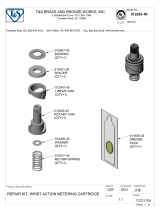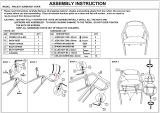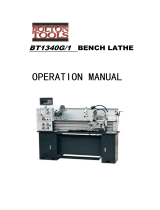
20
13.1.2 Bed Assembly – Parts List
Index No. Part No. Description Size Qty
101 ............ VB-A86 ...................... V-Belt ....................................................................... A86 ............................... 2
102 ............ D330A-11106-2 ......... Pulley ....................................................................... 60Hz ............................. 1
103 ............ GB1096 ..................... Key .......................................................................... 8x35mm ........................ 1
104 ............ TS-1490041 .............. Hex Cap Screw ........................................................ M8x25 ........................... 4
105 ............ TS-1550061 .............. Flat Washer ............................................................. M8 ................................. 4
106 ............ GH1440B-106 ........... Motor…………………………………………..1.8KW/220V/60HZ/1PH ............. 1
106-1 ......... GH1440B-106-SC ..... Start Capacitor ......................................................... 300MFD 350VAC .......... 1
106-2 ......... GH1440B-106-RC ..... Run Capacitor .......................................................... 40mF 350VAC .............. 1
107 ............ TS-2276081 .............. Socket Set Screw CP .............................................. M6x8 ............................. 1
108 ............ TS-1504061 .............. Hex Socket Hd Cap Screw ...................................... M8x30 ........................... 2
109 ............ TS-1490081 .............. Hex Cap Screw ........................................................ M8x45 ........................... 2
109a .......... TS-1540061 .............. Hex Nut .................................................................... M8 ................................. 2
110 ............ TS-1505051 .............. Hex Socket Hd Cap Screw ...................................... M10x35 ......................... 2
111 ............ TS-1550071 .............. Flat Washer ............................................................. M10 ............................... 7
112 ............ TS-1491061 .............. Hex Cap Screw ........................................................ M10x40 ......................... 2
113 ............ D330B-11107G ......... Motor Mount Plate ................................................... ...................................... 1
114 ............ TS-1491041 .............. Hex Cap Screw ........................................................ M10x30 ......................... 3
115 ............ TS-1505051 .............. Hex Socket Hd Cap Screw ...................................... M10x35 ......................... 2
116 ............ TS-1506051 .............. Hex Socket Hd Cap Screw ...................................... M12x40 ......................... 4
117 ............ GH1440B-117 ........... Taper Pin, Ext Thread ............................................. 8x70mm ........................ 2
117a .......... GB6170 ..................... Hex Nut .................................................................... M8 ................................. 2
118 ............ D330B-11103G ......... Gap Bridge .............................................................. ...................................... 1
119 ............ D330B-11101G ......... Bed .......................................................................... ...................................... 1
120 ............ TS-1504101 .............. Hex Socket Hd Cap Screw ...................................... M8x50 ........................... 2
121 ............ TS-1504061 .............. Hex Socket Hd Cap Screw ...................................... M8x30 ........................... 2
122 ............ ZX-C34 ...................... Taper pin ................................................................. 6x30mm ........................ 2
123 ............ GH1440B-123 ........... Taper pin, Int Thread ............................................... 4x36mm ........................ 1
125 ............ D330B-11203G ......... Control Rod ............................................................. ...................................... 1
126 ............ D330B-11202G ......... Feed Rod ................................................................. ...................................... 1
127 ............ D330B-11201G ......... Leadscrew ............................................................... ...................................... 1
128 ............ ZX-S13 ...................... Taper pin ................................................................. 5x20mm ........................ 8
129 ............ TS-1503041 .............. Hex Socket Hd Cap Screw ...................................... M6x16 ......................... 13
130 ............ D330B-11205G ......... Short rack ................................................................ ...................................... 1
131 ............ D330B-11204G ......... Long rack ................................................................. ...................................... 3
132 ............ F014000 .................... Key, Dbl Rd Hd ........................................................ 4x50mm ........................ 1
133 ............ D330B-11217G ......... Collar ....................................................................... ...................................... 1
134 ............ F010439 .................... Socket Set Screw FP ............................................... M8x8 ............................. 1
135 ............ GH1440B-135 ........... Spring ...................................................................... 6x1x15mm .................... 1
136 ............ D330B-11105G-1 ...... Pin ........................................................................... ...................................... 1
137 ............ GH1440B-137 ........... Spring ...................................................................... 32x3.6x50mm ............... 1
138 ............ D330B-11105G ......... Bracket .................................................................... ...................................... 1
139 ............ 5510484 .................... Roll Pin .................................................................... 5x20 .............................. 2
140 ............ GH1440B-140 ........... Knob ........................................................................ M10x50 ......................... 1
141 ............ D330B-11206G ......... Lever ........................................................................ ...................................... 1
142 ............ 5508804 .................... Roll Pin .................................................................... 4x20mm ........................ 1
143 ............ D330B-11104G ......... Fork ......................................................................... ...................................... 1
144 ............ TS-1523051 .............. Socket Set Screw CP .............................................. M6x16 ........................... 2
145 ............ TS-1540041 .............. Hex Nut .................................................................... M6 ................................. 2
146 ............ GH1440B-146 ........... Taper Pin, Int Thread ............................................... 6x45mm ........................ 2
147 ............ BDB919-021 .............. Ball Oiler .................................................................. 6mm .............................. 2
148 ............ TS-1504121 .............. Hex Socket Hd Cap Screw ...................................... M8x60 ........................... 2
149 ............ TS-1524031 .............. Socket Set Screw CP .............................................. M8x12 ........................... 1
150 ............ D330C-3012C ........... Cam ......................................................................... ...................................... 1
151 ............ F001217 .................... Phillips Pan Hd Mach Screw ................................... M8x12 ........................... 2
152 ............ F001218 .................... Phillips Pan Hd Mach Screw ................................... M4x42 ........................... 2
153 ............ D330C-11301C ......... Switch Box ............................................................... ...................................... 1
153a .......... D330C-11302C ......... Switch Box Cover .................................................... ...................................... 1
154 ............ GH1440B-154 ........... Switch ...................................................................... LXW5-11D1 .................. 2
155 ............ TS-1532032 .............. Phillips Pan Hd Mach Screw ................................... M4x10 ........................... 4
156 ............ D330B-11210G-1 ...... Cover ....................................................................... 19mm ............................ 1


























